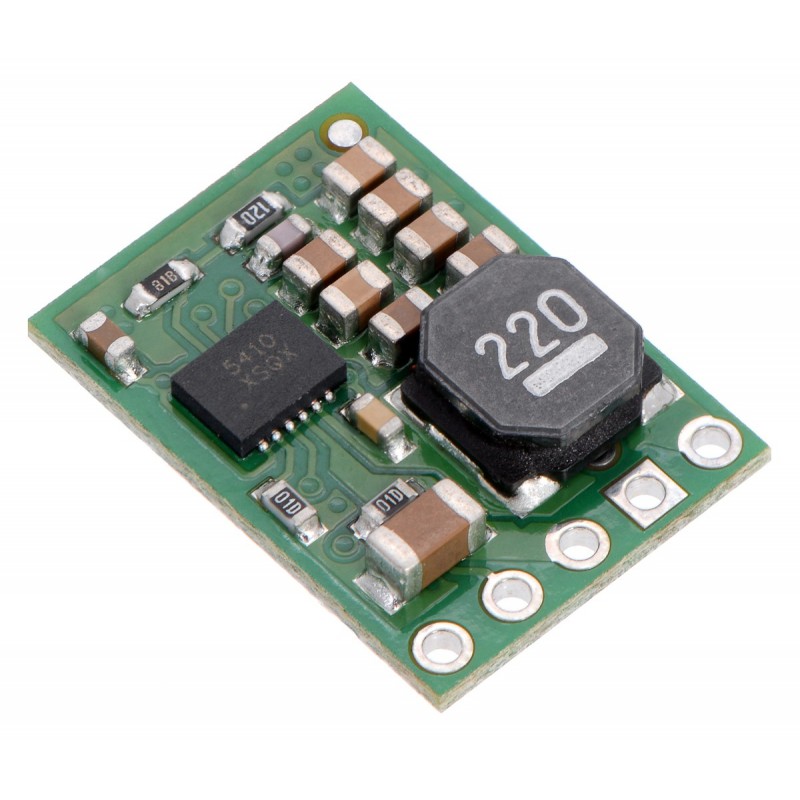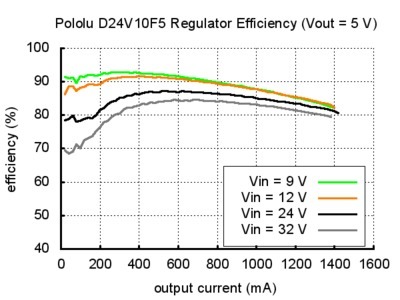

Pololu 5V, 1A Step-Down Voltage Regulator D24V10F5
The compact (0.5″ × 0.7″) D24V10F5 synchronous buck voltage regulator takes an input voltage of up to 36 V and efficiently reduces it to 5 V while allowing for a maximum output current of 1 A. This regulator offers typical efficiencies between 85% and 90% and has a very low dropout, so it can be used with input voltages as low as a few hundred millivolts above 5 V. The pins have a 0.1″ spacing, making this board compatible with standard solderless breadboards and perfboards.
Description
The D24V10Fx family of step-down voltage regulators features the Intersil ISL85410 1A synchronous buck regulator and generates lower output voltages from input voltages as high as 36 V. They are switching regulators (also called switched-mode power supplies (SMPS) or DC-to-DC converters) with typical efficiencies between 80% and 93%, which is much more efficient than linear voltage regulators, especially when the difference between the input and output voltage is large. These regulators have a power-save mode that activates at light loads and a low quiescent (no load) current draw, which make them well suited for applications that are run from a battery.
The different versions of this regulator all look very similar, so the bottom silkscreen includes a blank space where you can add your own distinguishing marks or labels. This product page applies to all five versions of the D24V10Fx family.
The SHDN pin can be used to put the board in a low-power state that reduces the quiescent current to approximately 10 µA to 20 µA per volt on VIN, and a PG (power good) output can be used to monitor the state of the regulator’s output voltage.
The regulators feature short-circuit/over-current protection, and thermal shutdown helps prevent damage from overheating. The boards do not have reverse-voltage protection.
Features
Connections
The buck regulator has five connections: power good (PG). shutdown (SHDN), input voltage (VIN), ground (GND), and output voltage (VOUT).
The “power good” indicator, PG, is an open-drain output that drives low when the regulator’s output voltage falls below 80% or rises above 120% of its target output voltage. This output is also actively held low for the duration of the regulator’s 2 ms soft-start period and while the regulator is being disabled by the SHDN input or by over-temperature or over-current fault conditions. An external pull-up resistor is generally required to use this pin.
The SHDN pin can be driven low (under 0.4 V) to turn off the output and put the board into a low-power state. There is a 100 kΩ pull-up resistor between the SHDN pin and VIN, so if you want to leave the board permanently enabled, the SHDN pin can be left disconnected. While the SHDN pin is being driven low, the current draw of the regulator is dominated by the current through the pull-up resistor and will be proportional to the input voltage. (At 36 V in it will draw about 360 μA.)
The input voltage, VIN, powers the regulator. Voltages between 3 V and 36 V can be applied to VIN, but the effective lower limit of VIN is VOUT plus the regulator’s dropout voltage, which varies approximately linearly with the load (see below for graphs of dropout voltages as a function of the load). Additionally, please be wary of destructive LC spikes (see below for more information).
The output voltage, VOUT, is fixed and depends on the regulator version: the D24V10F3 version outputs 3.3 V, the D24V10F5 version outputs 5 V, the D24V10F6 version outputs 6 V, the D24V10F9 version outputs 9 V, and the D24V10F12 version outputs 12 V.
Typical efficiency and output current
The efficiency of a voltage regulator, defined as (Power out)/(Power in), is an important measure of its performance, especially when battery life or heat are concerns. This family of switching regulators typically has an efficiency of 80% to 93%, though the actual efficiency in a given system depends on input voltage, output voltage, and output current. See the efficiency graph near the bottom of this page for more information.
In order to achieve a high efficiency at low loads, this regulator automatically goes into a power-save mode where the switching frequency is reduced. In power-save mode, the switching frequency of the regulator changes as necessary to minimize power loss. This could make it harder to filter out noise on the output caused by switching.
Typical dropout voltage
The dropout voltage of a step-down regulator is the minimum amount by which the input voltage must exceed the regulator’s target output voltage in order to ensure the target output can be achieved. For example, if a 5 V regulator has a 1 V dropout voltage, the input must be at least 6 V to ensure the output is the full 5 V. Generally speaking, the dropout voltage increases as the output current increases. See the “Details” section below for more information on the dropout voltage for this specific regulator version.
Details for item #2831
The graphs below show the typical efficiency and dropout voltage of the 5 V D24V10F5 regulator as a function of the output current:

.jpg)
LC voltage spikes
When connecting voltage to electronic circuits, the initial rush of current can cause voltage spikes that are much higher than the input voltage. If these spikes exceed the regulator’s maximum voltage (36 V), the regulator can be destroyed. In our tests with typical power leads (~30″ test clips), input voltages above 20 V caused spikes over 36 V.
Specifications
Download
Data sheet
Manufacturer BTC Korporacja sp. z o. o. Lwowska 5 05-120 Legionowo Poland sprzedaz@kamami.pl 22 767 36 20
Responsible person BTC Korporacja sp. z o. o. Lwowska 5 05-120 Legionowo Poland sprzedaz@kamami.pl 22 767 36 20
DC-DC step-down converter module 5V 16A used to convert energy from 6-24V input voltage to stable 5V, providing up to 16A current. Thanks to high conversion efficiency (over 90%) and low ripple (<20mV), it is ideal for powering sensitive devices in applications such as robotics, drones or LED lighting systems. Additionally, built-in overheating and short-circuit protection mechanisms ensure reliable operation even in difficult conditions. DFRobot DFR1202
The compact (0.4″ × 0.5″) D24V5F5 synchronous buck voltage regulator takes an input voltage of up to 36 V and efficiently reduces it to 5 V while allowing for a maximum output current of 500 mA. Pololu 2843
Step-Down DC-DC converter module based on the D36V6F5 chip. Input voltage 5.2..50V, output voltage 5V (max. 600mA). Pololu 3792
No product available!
Step-Down converter with an output voltage of 5 V, an input voltage of 6.5 to 16 V and a maximum current of 4 A
A power supply based on a DC-DC converter with a current capacity of up to 6.1 A. The input voltage can range from 6 V to 30 V, while the output voltage is adjustable from 0 V to 36 V. XYL3606S
Step-Down converter with adjustable output voltage from 1.25 to 36 V, input voltage from 4 to 38 V and maximum current up to 5 A
No product available!
Step-Down RT8272 converter with adjustable output voltage in the range from 5 V to 12 V, input voltage from 5 to 24 V and a maximum output current of 3 A
Step Down converter module with an output voltage of 5 V and a maximum current of 2x2,5 A. The board is equipped with four USB connectors
The compact (0.4″ × 0.5″) D24V5F15 synchronous buck voltage regulator takes an input voltage of up to 36 V and efficiently reduces it to 15 V while allowing for a maximum output current of 500 mA. Pololu 2847
Step-Down converter D36V50F9 with an output voltage of 9 V, an input voltage from 9.9 to 50 V and a maximum output current of 7 A. Pololu 4094
No product available!
DC-DC Step-Down converter module with 5V output voltage and 1A output current. The module can be a replacement for the popular LM7805 regulator.
No product available!
The DC-DC Step-down Converter Module with the LM2596S chip allows you to convert the voltage from the range of 3-40 V to a regulated output voltage of 1.5-35 V with high efficiency up to 92%. The maximum output current is 3 A, and the operating frequency is 150 kHz. The compact design with dimensions of 43 × 21 × 14 mm, the possibility of precise voltage regulation and a pinout of 2.54 mm facilitate the integration of the module in DIY projects, power supply systems, modeling and laboratory stations. The operating temperature range is from -40 to 85°C
Buck-mode DC-DC power module that converts voltage from 8 V to 28 V to a stable 5 V at a maximum current of 1.6 A, providing high conversion efficiency. Thanks to its small size, stability and reliability, the module is perfect for DIY projects, mobile power supply construction and applications requiring precise, stable voltage. DFRobot DFR0571
The Step-Down D24V3F3 Buck Voltage Regulator module gives the output voltage of 3,3V with a wide input voltage range of 4.3-42V and a maximum output current of 300 mA. Pololu 2097
No product available!
The compact (0.4″ × 0.5″) D24V5F9 synchronous buck voltage regulator takes an input voltage of up to 36 V and efficiently reduces it to 9 V while allowing for a maximum output current of 500 mA. Pololu 2845
No product available!
An efficient step-down converter that steps down the input voltage from as low as 45 V to a regulated output voltage range of 1.4 to 7 V, offering high efficiency and a maximum continuous current of 3.8 A. It has built-in reverse polarity, overload and short circuit protection, and the spread spectrum function reduces EMI interference. Pololu 4853

Pololu 2831
